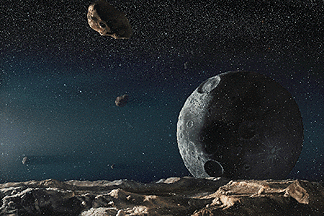 Planet
X
Planet
X Planet
X
Planet
XIs there a tenth planet to our solar system? The question has plagued astrologists for almost two centuries.
In 1841, a young amateur, John Couch Adams, began investigating unusually large residuals in the motion of Uranus. In 1845, Urbain LeVerrier noticed them too. Adams suggested that the deviations were caused by the gravitation of an unknown planet, but was not taken seriously. LeVerrier, on the other hand, presented his suggestion, but France lacked the necessary resources to locate the planet. Turning to the Berlin observatory, they found Neptune on the evening of 23 September 1846. However, Galle and his assistant d'Arrest were the original discoverers, but Adams and LeVerrier share the credit. Shortly after the discovery of Neptune, LeVerrier announced the possibility of there being another planet. A month later, Neptune's moon, Triton was discovered. This did not, however, account for the continuing deviations in Uranus' motion, which seemed to have been caused by two planets.
The first serious attempt to find a trans-Neptunian planet was embarked in 1877 by David Todd. Using a "graphical method," Todd derived that the planet had a mean distance of 52 AU, a period of 375 years, and a magnitude fainter than 13. Its longitude for 1877.84 was given 170 degrees. Many others compared their calculations with his and they were mostly a near match. Many other planets were hypothesized: Planet O, Q, and T. However, the concept of Planet X did not arrive until about 30 years after Todd's first attempt.
Percival Lowell, accreditted for discovering canals on Mars, performed several failed searches for his hypothetical Planet X. He started his second search in 1913, four years after his first. Lowell and others searched in vain for two years. Nearly a thousand plates were exposed, containing totals of 515 asteroids, 700 variable stars, and two images of Pluto. Ironically, Lowell and his companions never recognized the images of Pluto until its discovery in 1930. Lowell's failure of finding Planet X was the greatest disappointment of his life. He died in 1916.
The third search for Planet X continued with amateur astronomer and farmer, Clyde Tombaugh from Kansas in 1929. Most had given up on the search, agreeing that Planet X was Pluto. Tombaugh declared that Planet X must, if it was causing those pertubations in Uranus' orbit, larger than that. In fact, many astronomers believe that Pluto is not big enough to be considered a full-class planet. Tombaugh continued his search for another 13 years. In the end, he examined some 90 million images of some 30 million stars over more than 30,000 square degrees of sky. He found one new globlar cluster, a new supercluster, several small galaxy clusters, a new comet, five open star clusters, and about 775 new asteriods--but no new planet, but Pluto. He concluded that only a planet in an almost polar orbit and situated near the south celestial pole could have escaped his detection.
In recent years, NASA's Pioneer 10 and Pioneer 11, sent out in the 70s, appear to be perfectly stabilized--experiencing no changes in their speeds by the gravity seen back then. The new interpretation is that whaterever was there from 1819 to 1910 has not been there since, indicating that the planet would be on an elongated path around the sun. It (or they) is either a huge distance from the Sun, or is now orbiting on the far side of the Sun, opposite Uranus and Neptune. If there is a tenth planet with these qualities, it might explain why comets sometimes shoot into the inner Solar System. If it is not a planet, there is a possibility of it being the hypothetical brown-dwarf star, which has never been discovered.
Finally, in 1992, there was no "Planet X" to be found, but instead, the Kuiper Belt was discovered.
Home | Main Page | The Kuiper Belt | Planet X| Oort Cloud | 1996 TL66 | Bibliography | Related Links